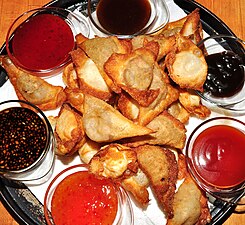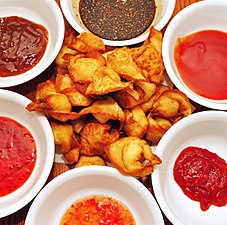food.wikisort.org - Dish
Crab Rangoon, sometimes called crab puffs,[1] crab rangoon puffs, or cheese wontons,[2] are filled crisp dumpling appetizers[3] served primarily in American Chinese restaurants.[1][2]
 | |
| Type | Dumpling |
|---|---|
| Course | Appetizer |
| Place of origin | United States |
| Main ingredients | Wonton wrapper, cream cheese, crab meat or imitation crab meat, scallions, garlic |
| Crab Rangoon | |||||||||||
|---|---|---|---|---|---|---|---|---|---|---|---|
| Chinese | 蟹角 | ||||||||||
| Hanyu Pinyin | xiè jiǎo | ||||||||||
| Cantonese Yale | háaih gok | ||||||||||
| Literal meaning | Crab horn | ||||||||||
| |||||||||||
| Alternative Chinese name | |||||||||||
| Traditional Chinese | 炸蟹角 | ||||||||||
| Hanyu Pinyin | zhǎ xiè jiǎo | ||||||||||
| Cantonese Yale | ja háaih gok | ||||||||||
| Literal meaning | Fried crab horn | ||||||||||
| |||||||||||
| Second alternative Chinese name | |||||||||||
| Traditional Chinese | 蟹仰光 | ||||||||||
| Hanyu Pinyin | xiè yǎng guāng | ||||||||||
| Cantonese Yale | háaih yéuhng gwōng | ||||||||||
| Literal meaning | Crab Rangoon | ||||||||||
| |||||||||||
Preparation
The filling is made with a combination of cream cheese, crab meat or imitation crab meat, scallions or onion, garlic, and other flavorings.[3][4][5][6] A small amount of the filling is wrapped in each wonton wrapper. The dumpling is then shaped by either folding the wrapper over into a triangle,[1][3][7][8][9] by creating a four-pointed star,[1][2] by gathering it up into a flower or purse shape,[1][5] or by twisting it into the traditional wonton shape.[6]
The appetizers are cooked to crispness by deep-frying in vegetable oil or by baking.[3][4][5] They can be served hot or cold.[3][5] In North America, Crab Rangoon is often served with a sauce for dipping such as soy sauce,[6][10] plum sauce,[11] duck sauce,[10][12] sweet and sour sauce,[1][4][7][10] or a hot mustard sauce.[8][13]
History
Crab Rangoon was on the menu of the "Polynesian-style" restaurant Trader Vic's in San Francisco since at least 1956.[14][15][16] Although the appetizer has the name of a Burmese city,[17] the dish was probably invented in the United States by Joe Young working under Victor Bergeron, founder of Trader Vic's.[18][17] A "Rangoon crab a la Jack" was mentioned as a dish at a Hawaiian-style party in 1952, but without further detail, and so may or may not be the same thing.[19]
Writing for Atlas Obscura, Dan Nosowitz points out that although cream cheese was a staple of 1940s and 1950s American cuisine, neither Chinese nor Burmese use cream cheese in their cuisines.[17] Since most East Asians are lactose intolerant,[20] including cream cheese in their diet would not be common for those cultures.
Names
They may be referred to as crab puffs, crab pillows, crab cheese wontons, or cheese wontons.
Gallery
- Triangular fried Crab Rangoons
- In the wonton shape, surrounded by dipping sauces
- Inside, showing the crisp shell, white filling, and golden dipping sauce.
See also
- Yau gok
- Curry beef turnover
- Crab puff
- List of crab dishes
- List of deep fried foods
- List of hors d'oeuvre
- List of seafood dishes
 Food portal
Food portal
References
- López-Alt, J. Kenji (2011). "Crab Rangoons (Crab Puffs) With Sweet and Sour Sauce Recipe". Serious Eats. Serious Eats Inc. Retrieved December 13, 2017.
- "Crab Rangoon (Cream Cheese Wontons)". Rasa Malaysia. Bee Interactive Corp. March 5, 2015. Retrieved December 13, 2017.
- Parkinson, R.L. (2003). The Everything Chinese Cookbook: From Wonton Soup to Sweet and Sour Chicken-300 Succelent Recipes from the Far East. F+W Media. p. 36. ISBN 978-1-60550-525-1. Retrieved November 5, 2016.
- Rossiter, M. (2011). Anti-Inflammation Diet For Dummies. Wiley. pp. 178–179. ISBN 978-1-118-14542-5. Retrieved November 5, 2016.
- Symon, Michael. "Crab Rangoon". The Chew. ABC Television Network. Archived from the original on 11 December 2017. Retrieved 10 December 2017.
- "CRAB RANGOON". Nasoya Recipes. Nasoya Foods USA, LLC. Retrieved 10 December 2017.
- Batali, Mario. "Crab Rangoon". The Chew. ABC Television Network. Archived from the original on April 27, 2018. Retrieved April 27, 2018.
- Lagasse, Emeril. "Crab Rangoon Pot Stickers With Hot Mustard Sauce". Emeril Lagasse. Emerils.com. Retrieved April 27, 2018.
- Farmer, Brooke. "Healthy Baked Crab Rangoon". brookeanddaron.com. Retrieved August 6, 2019.
- "Crab Rangoon". weightwatchers. Weight Watchers International, Inc. 2018. Retrieved April 27, 2018.
Notes: Serve with reduced-sodium soy sauce mixed with chopped scallions or prepared sweet-and-sour or duck sauce, if desired. Just make sure to account for any increase in SmartPoints values.
- Menu: Dim Sum, P.F. Chang’s China Bistro, Inc., 2017, archived from the original on April 27, 2018, retrieved April 27, 2018,
Hand-Folded Crab Wontons » Creamy crab filling, bell pepper, green onion, spicy plum sauce
- Hirsch, J.M. (April 25, 2007). "How to make Crab rangoon — without the deep fry". The Courier. Lee Enterprises, Incorporated. Retrieved April 27, 2018.
- Lagasse, Emeril. "Hot Mustard Sauce". Emeril Lagasse. Emerils.com. Retrieved April 27, 2018.
- Escobosa, Hector (August 1956). "Ask the Man Who Knows". Town & Country. Vol. 110, no. 4405. p. 38-39. ProQuest 2133385809 – via Google Books.
Victor Bergeron, or The Trader, as he is affectionately known to thousand of San Franciscans, opened his first restaurant in Oakland in 1934... The traditional beginning for any meal at Trader Vic's is barbecued spareribs, cooked to a king's taste in a 550°F Chinese oven. These may be taken with your before-dinner cocktail and an be varied with Cosmo Tidbits (fried shrimp, spareribs, Crab Ragoon, sliced pork) or Malayan Tidbits (Rumaki, cheese balls, curry puffs).
- Caen, Herb (1957). Herb Caen's guide to San Francisco. Doubleday. p. 100 – via Google Books.
- Cronin, Ned (January 16, 1957). "Cronin's Corner". Los Angeles Times. p. c3. ProQuest 167063622.
Anyhow, Abe has become a gourmet. An epicure, no less... For the entree, there's the wiener schnitzel at the Frankfurt Hof in Frankfort; the incomparable roast beef at Toots Shor's; the Cornish game hen at Ernie's in San Francisco and the Crab Rangoon at Trader Vic's in Oakland...
- Nosowitz, Dan (August 14, 2019). "What the Heck Is Crab Rangoon Anyway?". Atlas Obscura. Retrieved January 3, 2020.
- Walkup, Carolyn (March 6, 2006). "Trader Vic's to resume U.S., foreign expansion". Nation's Restaurant News. Archived from the original on June 30, 2012. Retrieved May 21, 2009.
- Lesh, Anne Ryan (May 24, 1952). "National President Entertained by Engineers Auxiliary". Pittsburgh Post-Gazette. p. 5 – via Google Books.
- Goh, Li-Han; Said, Rosaida Mohd; Goh, Khean-Lee (2018). "Lactase deficiency and lactose intolerance in a multiracial Asian population in Malaysia". JGH Open. 2 (6): 307–310. doi:10.1002/jgh3.12089. PMID 30619942.
Другой контент может иметь иную лицензию. Перед использованием материалов сайта WikiSort.org внимательно изучите правила лицензирования конкретных элементов наполнения сайта.
WikiSort.org - проект по пересортировке и дополнению контента Википедии


